FIAT FULLBACK 2017 Owner handbook (in English)
Manufacturer: FIAT, Model Year: 2017, Model line: FULLBACK, Model: FIAT FULLBACK 2017Pages: 312, PDF Size: 12.31 MB
Page 261 of 312
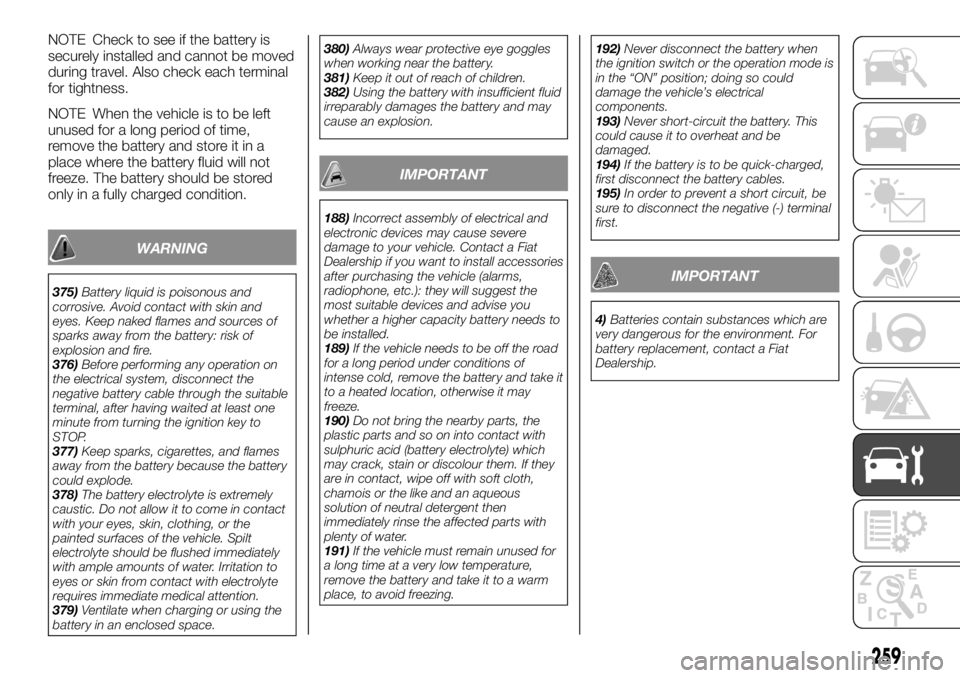
NOTE Check to see if the battery is
securely installed and cannot be moved
during travel. Also check each terminal
for tightness.
NOTE When the vehicle is to be left
unused for a long period of time,
remove the battery and store it in a
place where the battery fluid will not
freeze. The battery should be stored
only in a fully charged condition.
WARNING
375)Battery liquid is poisonous and
corrosive. Avoid contact with skin and
eyes. Keep naked flames and sources of
sparks away from the battery: risk of
explosion and fire.
376)Before performing any operation on
the electrical system, disconnect the
negative battery cable through the suitable
terminal, after having waited at least one
minute from turning the ignition key to
STOP.
377)Keep sparks, cigarettes, and flames
away from the battery because the battery
could explode.
378)The battery electrolyte is extremely
caustic. Do not allow it to come in contact
with your eyes, skin, clothing, or the
painted surfaces of the vehicle. Spilt
electrolyte should be flushed immediately
with ample amounts of water. Irritation to
eyes or skin from contact with electrolyte
requires immediate medical attention.
379)Ventilate when charging or using the
battery in an enclosed space.380)Always wear protective eye goggles
when working near the battery.
381)Keep it out of reach of children.
382)Using the battery with insufficient fluid
irreparably damages the battery and may
cause an explosion.
IMPORTANT
188)Incorrect assembly of electrical and
electronic devices may cause severe
damage to your vehicle. Contact a Fiat
Dealership if you want to install accessories
after purchasing the vehicle (alarms,
radiophone, etc.): they will suggest the
most suitable devices and advise you
whether a higher capacity battery needs to
be installed.
189)If the vehicle needs to be off the road
for a long period under conditions of
intense cold, remove the battery and take it
to a heated location, otherwise it may
freeze.
190)Do not bring the nearby parts, the
plastic parts and so on into contact with
sulphuric acid (battery electrolyte) which
may crack, stain or discolour them. If they
are in contact, wipe off with soft cloth,
chamois or the like and an aqueous
solution of neutral detergent then
immediately rinse the affected parts with
plenty of water.
191)If the vehicle must remain unused for
a long time at a very low temperature,
remove the battery and take it to a warm
place, to avoid freezing.192)Never disconnect the battery when
the ignition switch or the operation mode is
in the “ON” position; doing so could
damage the vehicle’s electrical
components.
193)Never short-circuit the battery. This
could cause it to overheat and be
damaged.
194)If the battery is to be quick-charged,
first disconnect the battery cables.
195)In order to prevent a short circuit, be
sure to disconnect the negative (-) terminal
first.
IMPORTANT
4)Batteries contain substances which are
very dangerous for the environment. For
battery replacement, contact a Fiat
Dealership.
259
Page 262 of 312
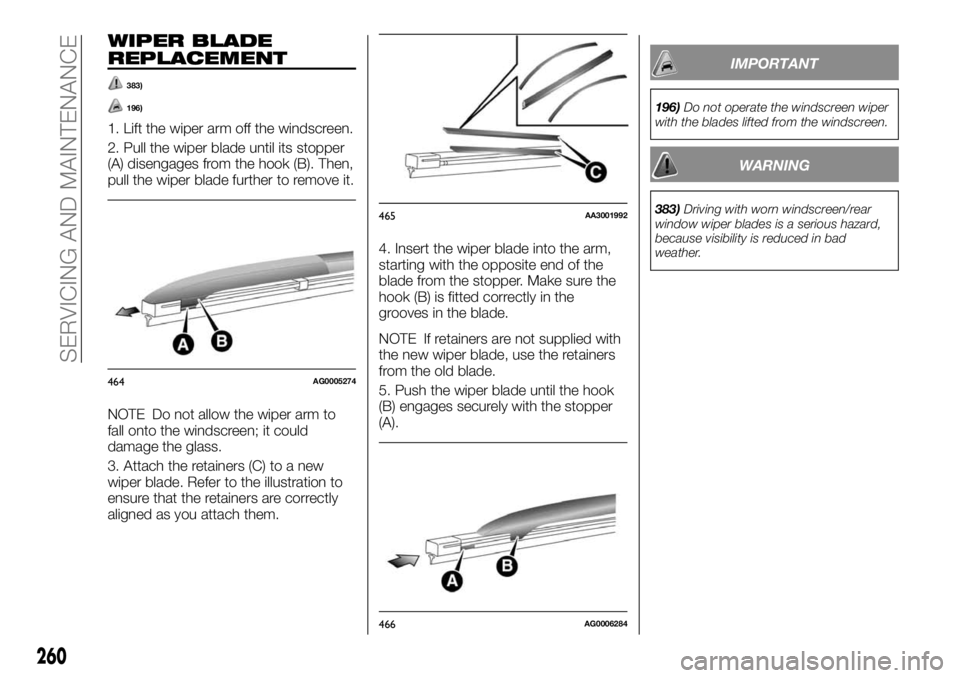
WIPER BLADE
REPLACEMENT
383)
196)
1. Lift the wiper arm off the windscreen.
2. Pull the wiper blade until its stopper
(A) disengages from the hook (B). Then,
pull the wiper blade further to remove it.
NOTE Do not allow the wiper arm to
fall onto the windscreen; it could
damage the glass.
3. Attach the retainers (C) to a new
wiper blade. Refer to the illustration to
ensure that the retainers are correctly
aligned as you attach them.4. Insert the wiper blade into the arm,
starting with the opposite end of the
blade from the stopper. Make sure the
hook (B) is fitted correctly in the
grooves in the blade.
NOTE If retainers are not supplied with
the new wiper blade, use the retainers
from the old blade.
5. Push the wiper blade until the hook
(B) engages securely with the stopper
(A).
IMPORTANT
196)Do not operate the windscreen wiper
with the blades lifted from the windscreen.
WARNING
383)Driving with worn windscreen/rear
window wiper blades is a serious hazard,
because visibility is reduced in bad
weather.
464AG0005274
465AA3001992
466AG0006284
260
SERVICING AND MAINTENANCE
Page 263 of 312
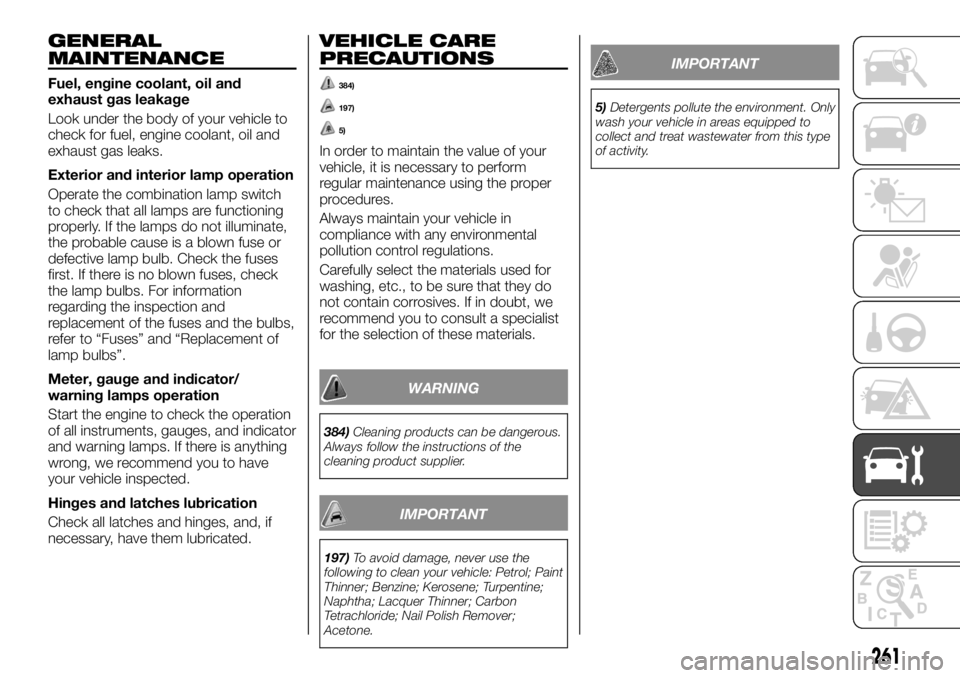
GENERAL
MAINTENANCE
Fuel, engine coolant, oil and
exhaust gas leakage
Look under the body of your vehicle to
check for fuel, engine coolant, oil and
exhaust gas leaks.
Exterior and interior lamp operation
Operate the combination lamp switch
to check that all lamps are functioning
properly. If the lamps do not illuminate,
the probable cause is a blown fuse or
defective lamp bulb. Check the fuses
first. If there is no blown fuses, check
the lamp bulbs. For information
regarding the inspection and
replacement of the fuses and the bulbs,
refer to “Fuses” and “Replacement of
lamp bulbs”.
Meter, gauge and indicator/
warning lamps operation
Start the engine to check the operation
of all instruments, gauges, and indicator
and warning lamps. If there is anything
wrong, we recommend you to have
your vehicle inspected.
Hinges and latches lubrication
Check all latches and hinges, and, if
necessary, have them lubricated.
VEHICLE CARE
PRECAUTIONS
384)
197)
5)
In order to maintain the value of your
vehicle, it is necessary to perform
regular maintenance using the proper
procedures.
Always maintain your vehicle in
compliance with any environmental
pollution control regulations.
Carefully select the materials used for
washing, etc., to be sure that they do
not contain corrosives. If in doubt, we
recommend you to consult a specialist
for the selection of these materials.
WARNING
384)Cleaning products can be dangerous.
Always follow the instructions of the
cleaning product supplier.
IMPORTANT
197)To avoid damage, never use the
following to clean your vehicle: Petrol; Paint
Thinner; Benzine; Kerosene; Turpentine;
Naphtha; Lacquer Thinner; Carbon
Tetrachloride; Nail Polish Remover;
Acetone.
IMPORTANT
5)Detergents pollute the environment. Only
wash your vehicle in areas equipped to
collect and treat wastewater from this type
of activity.
261
Page 264 of 312
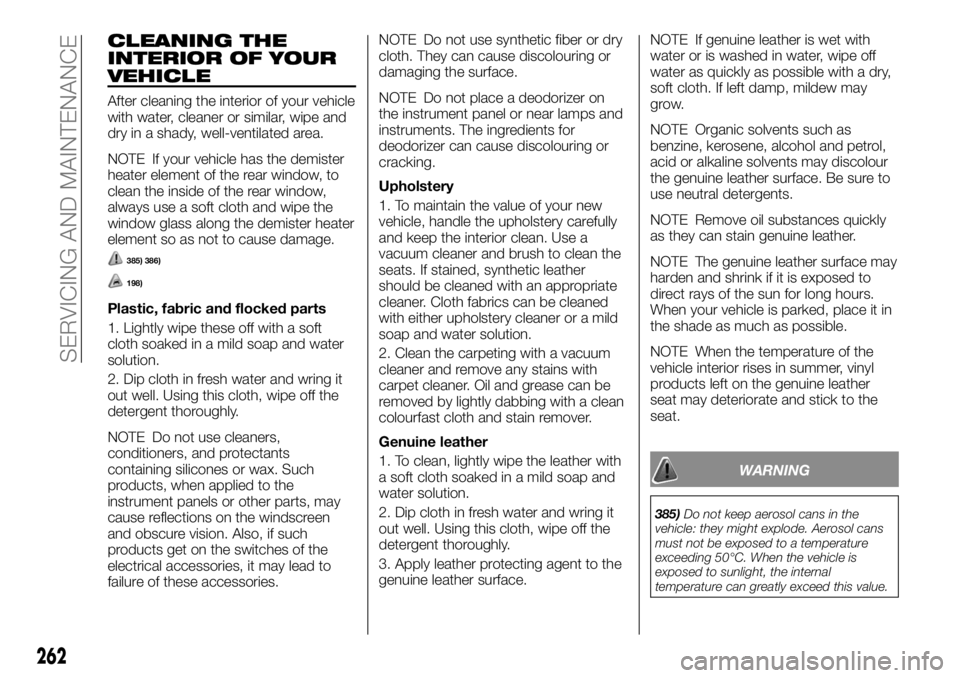
CLEANING THE
INTERIOR OF YOUR
VEHICLE
After cleaning the interior of your vehicle
with water, cleaner or similar, wipe and
dry in a shady, well-ventilated area.
NOTE If your vehicle has the demister
heater element of the rear window, to
clean the inside of the rear window,
always use a soft cloth and wipe the
window glass along the demister heater
element so as not to cause damage.
385) 386)
198)
Plastic, fabric and flocked parts
1. Lightly wipe these off with a soft
cloth soaked in a mild soap and water
solution.
2. Dip cloth in fresh water and wring it
out well. Using this cloth, wipe off the
detergent thoroughly.
NOTE Do not use cleaners,
conditioners, and protectants
containing silicones or wax. Such
products, when applied to the
instrument panels or other parts, may
cause reflections on the windscreen
and obscure vision. Also, if such
products get on the switches of the
electrical accessories, it may lead to
failure of these accessories.NOTE Do not use synthetic fiber or dry
cloth. They can cause discolouring or
damaging the surface.
NOTE Do not place a deodorizer on
the instrument panel or near lamps and
instruments. The ingredients for
deodorizer can cause discolouring or
cracking.
Upholstery
1. To maintain the value of your new
vehicle, handle the upholstery carefully
and keep the interior clean. Use a
vacuum cleaner and brush to clean the
seats. If stained, synthetic leather
should be cleaned with an appropriate
cleaner. Cloth fabrics can be cleaned
with either upholstery cleaner or a mild
soap and water solution.
2. Clean the carpeting with a vacuum
cleaner and remove any stains with
carpet cleaner. Oil and grease can be
removed by lightly dabbing with a clean
colourfast cloth and stain remover.
Genuine leather
1. To clean, lightly wipe the leather with
a soft cloth soaked in a mild soap and
water solution.
2. Dip cloth in fresh water and wring it
out well. Using this cloth, wipe off the
detergent thoroughly.
3. Apply leather protecting agent to the
genuine leather surface.NOTE If genuine leather is wet with
water or is washed in water, wipe off
water as quickly as possible with a dry,
soft cloth. If left damp, mildew may
grow.
NOTE Organic solvents such as
benzine, kerosene, alcohol and petrol,
acid or alkaline solvents may discolour
the genuine leather surface. Be sure to
use neutral detergents.
NOTE Remove oil substances quickly
as they can stain genuine leather.
NOTE The genuine leather surface may
harden and shrink if it is exposed to
direct rays of the sun for long hours.
When your vehicle is parked, place it in
the shade as much as possible.
NOTE When the temperature of the
vehicle interior rises in summer, vinyl
products left on the genuine leather
seat may deteriorate and stick to the
seat.
WARNING
385)Do not keep aerosol cans in the
vehicle: they might explode. Aerosol cans
must not be exposed to a temperature
exceeding 50°C. When the vehicle is
exposed to sunlight, the internal
temperature can greatly exceed this value.
262
SERVICING AND MAINTENANCE
Page 265 of 312
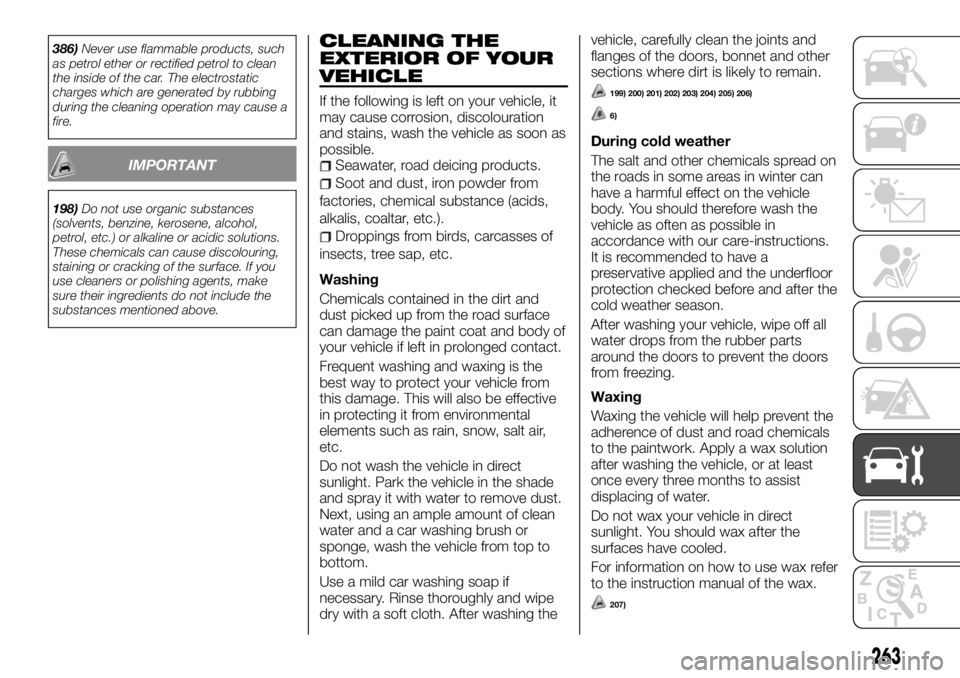
386)Never use flammable products, such
as petrol ether or rectified petrol to clean
the inside of the car. The electrostatic
charges which are generated by rubbing
during the cleaning operation may cause a
fire.
IMPORTANT
198)Do not use organic substances
(solvents, benzine, kerosene, alcohol,
petrol, etc.) or alkaline or acidic solutions.
These chemicals can cause discolouring,
staining or cracking of the surface. If you
use cleaners or polishing agents, make
sure their ingredients do not include the
substances mentioned above.
CLEANING THE
EXTERIOR OF YOUR
VEHICLE
If the following is left on your vehicle, it
may cause corrosion, discolouration
and stains, wash the vehicle as soon as
possible.
Seawater, road deicing products.
Soot and dust, iron powder from
factories, chemical substance (acids,
alkalis, coaltar, etc.).
Droppings from birds, carcasses of
insects, tree sap, etc.
Washing
Chemicals contained in the dirt and
dust picked up from the road surface
can damage the paint coat and body of
your vehicle if left in prolonged contact.
Frequent washing and waxing is the
best way to protect your vehicle from
this damage. This will also be effective
in protecting it from environmental
elements such as rain, snow, salt air,
etc.
Do not wash the vehicle in direct
sunlight. Park the vehicle in the shade
and spray it with water to remove dust.
Next, using an ample amount of clean
water and a car washing brush or
sponge, wash the vehicle from top to
bottom.
Use a mild car washing soap if
necessary. Rinse thoroughly and wipe
dry with a soft cloth. After washing thevehicle, carefully clean the joints and
flanges of the doors, bonnet and other
sections where dirt is likely to remain.
199) 200) 201) 202) 203) 204) 205) 206)
6)
During cold weather
The salt and other chemicals spread on
the roads in some areas in winter can
have a harmful effect on the vehicle
body. You should therefore wash the
vehicle as often as possible in
accordance with our care-instructions.
It is recommended to have a
preservative applied and the underfloor
protection checked before and after the
cold weather season.
After washing your vehicle, wipe off all
water drops from the rubber parts
around the doors to prevent the doors
from freezing.
Waxing
Waxing the vehicle will help prevent the
adherence of dust and road chemicals
to the paintwork. Apply a wax solution
after washing the vehicle, or at least
once every three months to assist
displacing of water.
Do not wax your vehicle in direct
sunlight. You should wax after the
surfaces have cooled.
For information on how to use wax refer
to the instruction manual of the wax.
207)
263
Page 266 of 312
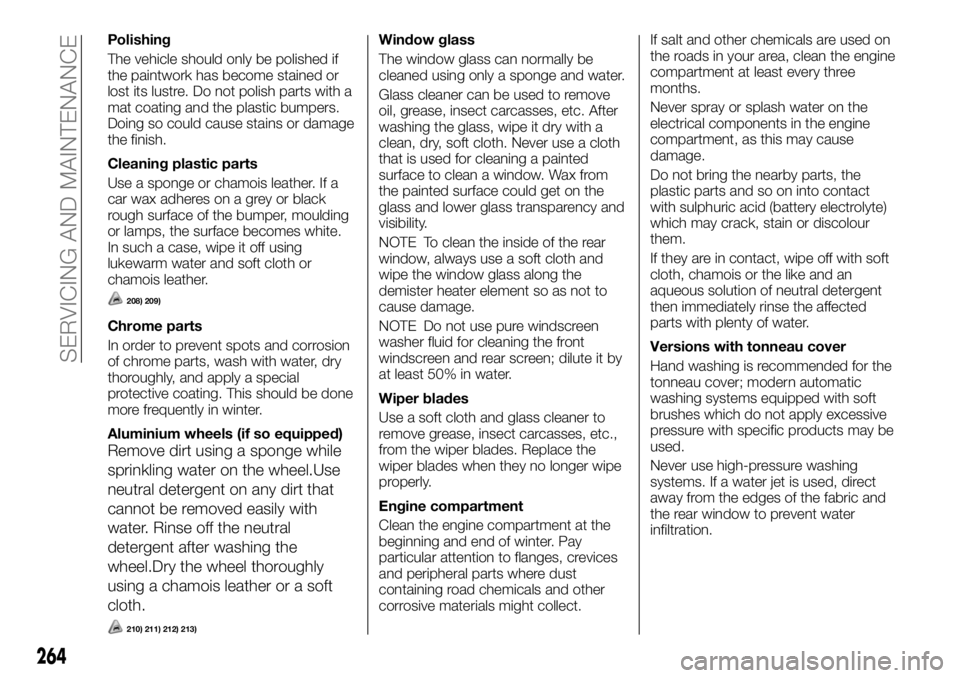
Polishing
The vehicle should only be polished if
the paintwork has become stained or
lost its lustre. Do not polish parts with a
mat coating and the plastic bumpers.
Doing so could cause stains or damage
the finish.
Cleaning plastic parts
Use a sponge or chamois leather. If a
car wax adheres on a grey or black
rough surface of the bumper, moulding
or lamps, the surface becomes white.
In such a case, wipe it off using
lukewarm water and soft cloth or
chamois leather.
208) 209)
Chrome parts
In order to prevent spots and corrosion
of chrome parts, wash with water, dry
thoroughly, and apply a special
protective coating. This should be done
more frequently in winter.
Aluminium wheels (if so equipped)
Remove dirt using a sponge while
sprinkling water on the wheel.Use
neutral detergent on any dirt that
cannot be removed easily with
water. Rinse off the neutral
detergent after washing the
wheel.Dry the wheel thoroughly
using a chamois leather or a soft
cloth.
210) 211) 212) 213)
Window glass
The window glass can normally be
cleaned using only a sponge and water.
Glass cleaner can be used to remove
oil, grease, insect carcasses, etc. After
washing the glass, wipe it dry with a
clean, dry, soft cloth. Never use a cloth
that is used for cleaning a painted
surface to clean a window. Wax from
the painted surface could get on the
glass and lower glass transparency and
visibility.
NOTE To clean the inside of the rear
window, always use a soft cloth and
wipe the window glass along the
demister heater element so as not to
cause damage.
NOTE Do not use pure windscreen
washer fluid for cleaning the front
windscreen and rear screen; dilute it by
at least 50% in water.
Wiper blades
Use a soft cloth and glass cleaner to
remove grease, insect carcasses, etc.,
from the wiper blades. Replace the
wiper blades when they no longer wipe
properly.
Engine compartment
Clean the engine compartment at the
beginning and end of winter. Pay
particular attention to flanges, crevices
and peripheral parts where dust
containing road chemicals and other
corrosive materials might collect.If salt and other chemicals are used on
the roads in your area, clean the engine
compartment at least every three
months.
Never spray or splash water on the
electrical components in the engine
compartment, as this may cause
damage.
Do not bring the nearby parts, the
plastic parts and so on into contact
with sulphuric acid (battery electrolyte)
which may crack, stain or discolour
them.
If they are in contact, wipe off with soft
cloth, chamois or the like and an
aqueous solution of neutral detergent
then immediately rinse the affected
parts with plenty of water.
Versions with tonneau cover
Hand washing is recommended for the
tonneau cover; modern automatic
washing systems equipped with soft
brushes which do not apply excessive
pressure with specific products may be
used.
Never use high-pressure washing
systems. If a water jet is used, direct
away from the edges of the fabric and
the rear window to prevent water
infiltration.
264
SERVICING AND MAINTENANCE
Page 267 of 312
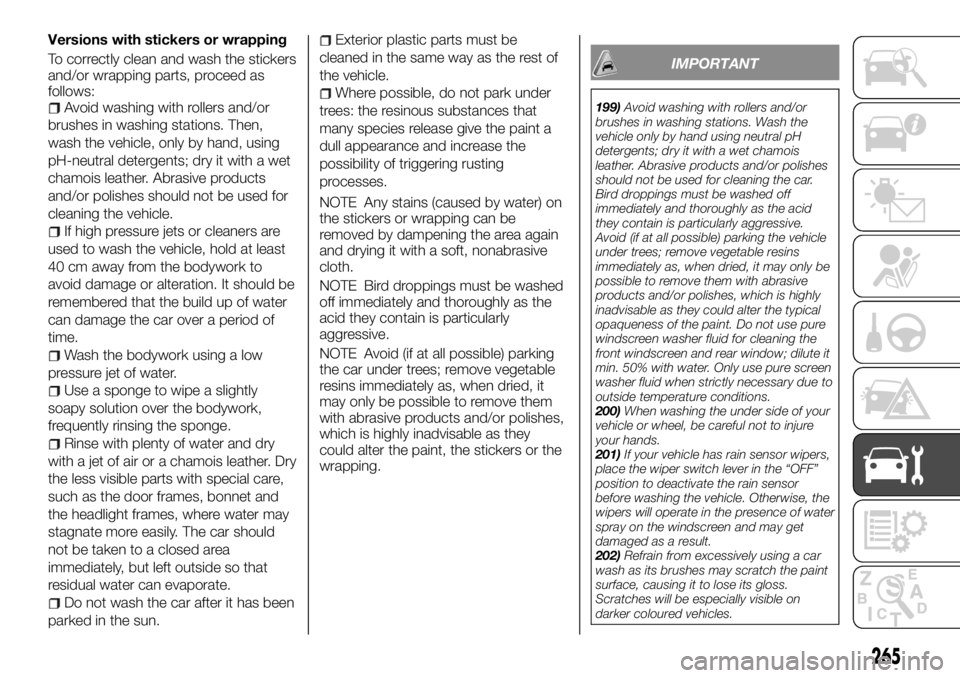
Versions with stickers or wrapping
To correctly clean and wash the stickers
and/or wrapping parts, proceed as
follows:
Avoid washing with rollers and/or
brushes in washing stations. Then,
wash the vehicle, only by hand, using
pH-neutral detergents; dry it with a wet
chamois leather. Abrasive products
and/or polishes should not be used for
cleaning the vehicle.
If high pressure jets or cleaners are
used to wash the vehicle, hold at least
40 cm away from the bodywork to
avoid damage or alteration. It should be
remembered that the build up of water
can damage the car over a period of
time.
Wash the bodywork using a low
pressure jet of water.
Use a sponge to wipe a slightly
soapy solution over the bodywork,
frequently rinsing the sponge.
Rinse with plenty of water and dry
with a jet of air or a chamois leather. Dry
the less visible parts with special care,
such as the door frames, bonnet and
the headlight frames, where water may
stagnate more easily. The car should
not be taken to a closed area
immediately, but left outside so that
residual water can evaporate.
Do not wash the car after it has been
parked in the sun.
Exterior plastic parts must be
cleaned in the same way as the rest of
the vehicle.
Where possible, do not park under
trees: the resinous substances that
many species release give the paint a
dull appearance and increase the
possibility of triggering rusting
processes.
NOTE Any stains (caused by water) on
the stickers or wrapping can be
removed by dampening the area again
and drying it with a soft, nonabrasive
cloth.
NOTE Bird droppings must be washed
off immediately and thoroughly as the
acid they contain is particularly
aggressive.
NOTE Avoid (if at all possible) parking
the car under trees; remove vegetable
resins immediately as, when dried, it
may only be possible to remove them
with abrasive products and/or polishes,
which is highly inadvisable as they
could alter the paint, the stickers or the
wrapping.
IMPORTANT
199)Avoid washing with rollers and/or
brushes in washing stations. Wash the
vehicle only by hand using neutral pH
detergents; dry it with a wet chamois
leather. Abrasive products and/or polishes
should not be used for cleaning the car.
Bird droppings must be washed off
immediately and thoroughly as the acid
they contain is particularly aggressive.
Avoid (if at all possible) parking the vehicle
under trees; remove vegetable resins
immediately as, when dried, it may only be
possible to remove them with abrasive
products and/or polishes, which is highly
inadvisable as they could alter the typical
opaqueness of the paint. Do not use pure
windscreen washer fluid for cleaning the
front windscreen and rear window; dilute it
min. 50% with water. Only use pure screen
washer fluid when strictly necessary due to
outside temperature conditions.
200)When washing the under side of your
vehicle or wheel, be careful not to injure
your hands.
201)If your vehicle has rain sensor wipers,
place the wiper switch lever in the “OFF”
position to deactivate the rain sensor
before washing the vehicle. Otherwise, the
wipers will operate in the presence of water
spray on the windscreen and may get
damaged as a result.
202)Refrain from excessively using a car
wash as its brushes may scratch the paint
surface, causing it to lose its gloss.
Scratches will be especially visible on
darker coloured vehicles.
265
Page 268 of 312
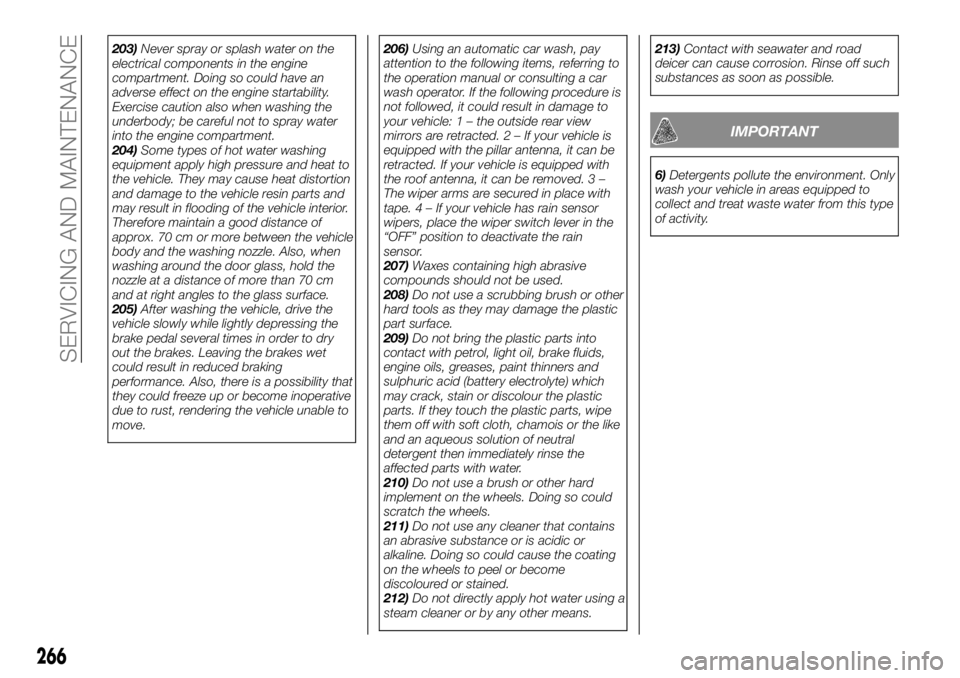
203)Never spray or splash water on the
electrical components in the engine
compartment. Doing so could have an
adverse effect on the engine startability.
Exercise caution also when washing the
underbody; be careful not to spray water
into the engine compartment.
204)Some types of hot water washing
equipment apply high pressure and heat to
the vehicle. They may cause heat distortion
and damage to the vehicle resin parts and
may result in flooding of the vehicle interior.
Therefore maintain a good distance of
approx. 70 cm or more between the vehicle
body and the washing nozzle. Also, when
washing around the door glass, hold the
nozzle at a distance of more than 70 cm
and at right angles to the glass surface.
205)After washing the vehicle, drive the
vehicle slowly while lightly depressing the
brake pedal several times in order to dry
out the brakes. Leaving the brakes wet
could result in reduced braking
performance. Also, there is a possibility that
they could freeze up or become inoperative
due to rust, rendering the vehicle unable to
move.206)Using an automatic car wash, pay
attention to the following items, referring to
the operation manual or consulting a car
wash operator. If the following procedure is
not followed, it could result in damage to
your vehicle: 1 – the outside rear view
mirrors are retracted.2–Ifyour vehicle is
equipped with the pillar antenna, it can be
retracted. If your vehicle is equipped with
the roof antenna, it can be removed. 3 –
The wiper arms are secured in place with
tape.4–Ifyour vehicle has rain sensor
wipers, place the wiper switch lever in the
“OFF” position to deactivate the rain
sensor.
207)Waxes containing high abrasive
compounds should not be used.
208)Do not use a scrubbing brush or other
hard tools as they may damage the plastic
part surface.
209)Do not bring the plastic parts into
contact with petrol, light oil, brake fluids,
engine oils, greases, paint thinners and
sulphuric acid (battery electrolyte) which
may crack, stain or discolour the plastic
parts. If they touch the plastic parts, wipe
them off with soft cloth, chamois or the like
and an aqueous solution of neutral
detergent then immediately rinse the
affected parts with water.
210)Do not use a brush or other hard
implement on the wheels. Doing so could
scratch the wheels.
211)Do not use any cleaner that contains
an abrasive substance or is acidic or
alkaline. Doing so could cause the coating
on the wheels to peel or become
discoloured or stained.
212)Do not directly apply hot water using a
steam cleaner or by any other means.213)Contact with seawater and road
deicer can cause corrosion. Rinse off such
substances as soon as possible.
IMPORTANT
6)Detergents pollute the environment. Only
wash your vehicle in areas equipped to
collect and treat waste water from this type
of activity.
266
SERVICING AND MAINTENANCE
Page 269 of 312
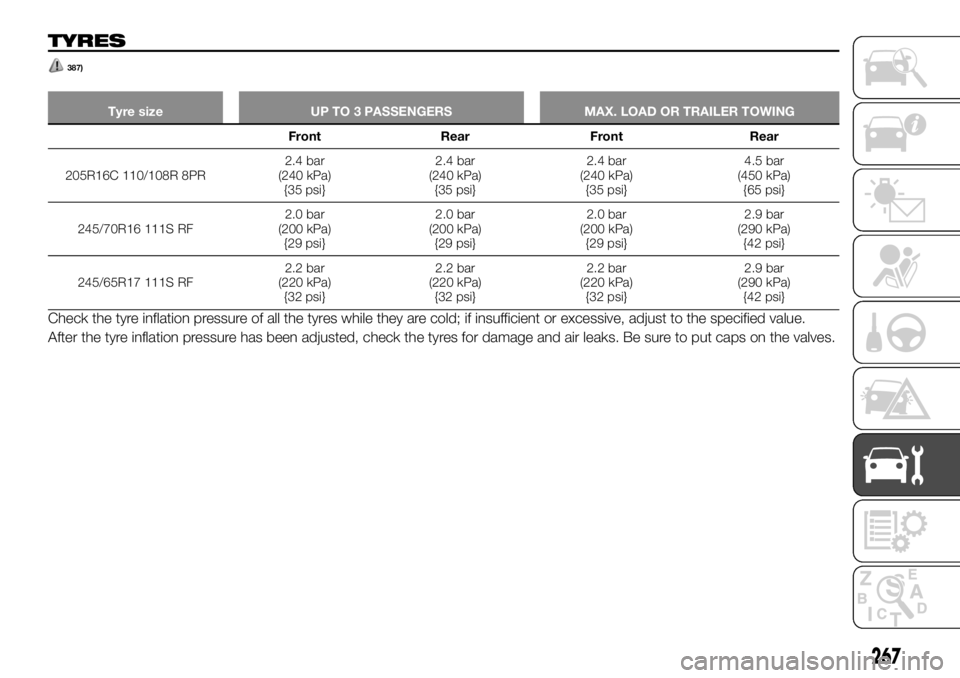
TYRES
387)
Tyre size UP TO 3 PASSENGERS MAX. LOAD OR TRAILER TOWING
Front Rear Front Rear
205R16C 110/108R 8PR2.4 bar
(240 kPa)
{35 psi}2.4 bar
(240 kPa)
{35 psi}2.4 bar
(240 kPa)
{35 psi}4.5 bar
(450 kPa)
{65 psi}
245/70R16 111S RF2.0 bar
(200 kPa)
{29 psi}2.0 bar
(200 kPa)
{29 psi}2.0 bar
(200 kPa)
{29 psi}2.9 bar
(290 kPa)
{42 psi}
245/65R17 111S RF2.2 bar
(220 kPa)
{32 psi}2.2 bar
(220 kPa)
{32 psi}2.2 bar
(220 kPa)
{32 psi}2.9 bar
(290 kPa)
{42 psi}
Check the tyre inflation pressure of all the tyres while they are cold; if insufficient or excessive, adjust to the specified value.
After the tyre inflation pressure has been adjusted, check the tyres for damage and air leaks. Be sure to put caps on the valves.
267
Page 270 of 312
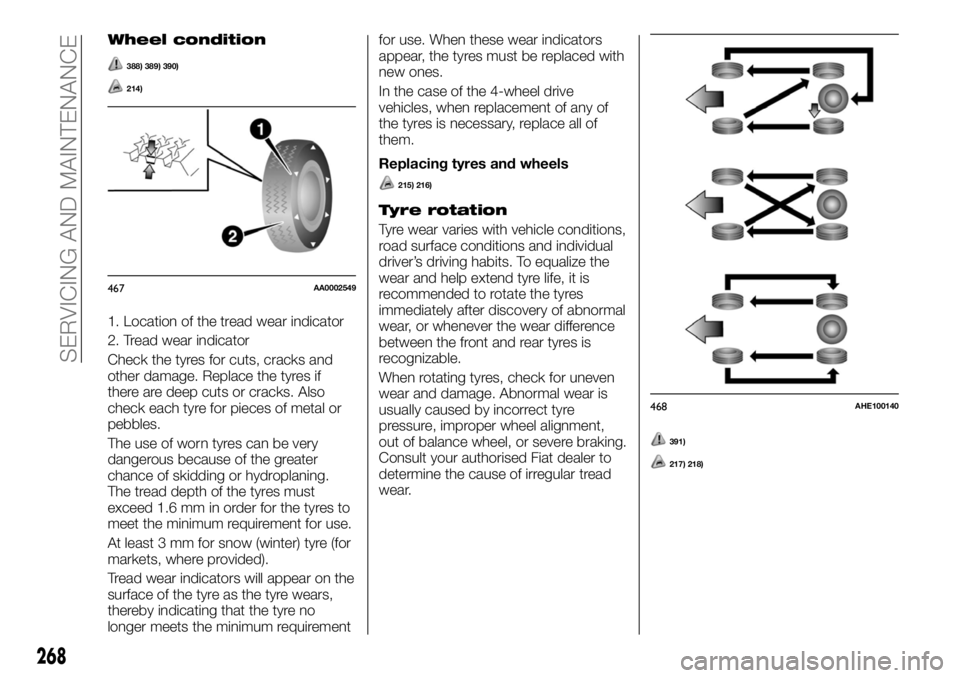
Wheel condition
388) 389) 390)
214)
1. Location of the tread wear indicator
2. Tread wear indicator
Check the tyres for cuts, cracks and
other damage. Replace the tyres if
there are deep cuts or cracks. Also
check each tyre for pieces of metal or
pebbles.
The use of worn tyres can be very
dangerous because of the greater
chance of skidding or hydroplaning.
The tread depth of the tyres must
exceed 1.6 mm in order for the tyres to
meet the minimum requirement for use.
At least 3 mm for snow (winter) tyre (for
markets, where provided).
Tread wear indicators will appear on the
surface of the tyre as the tyre wears,
thereby indicating that the tyre no
longer meets the minimum requirementfor use. When these wear indicators
appear, the tyres must be replaced with
new ones.
In the case of the 4-wheel drive
vehicles, when replacement of any of
the tyres is necessary, replace all of
them.
Replacing tyres and wheels
215) 216)
Tyre rotation
Tyre wear varies with vehicle conditions,
road surface conditions and individual
driver’s driving habits. To equalize the
wear and help extend tyre life, it is
recommended to rotate the tyres
immediately after discovery of abnormal
wear, or whenever the wear difference
between the front and rear tyres is
recognizable.
When rotating tyres, check for uneven
wear and damage. Abnormal wear is
usually caused by incorrect tyre
pressure, improper wheel alignment,
out of balance wheel, or severe braking.
Consult your authorised Fiat dealer to
determine the cause of irregular tread
wear.
391)
217) 218)
467AA0002549
468AHE100140
268
SERVICING AND MAINTENANCE